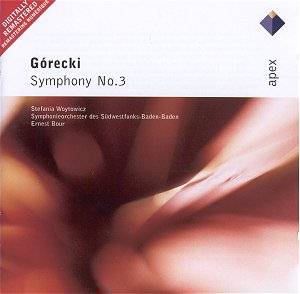Of the modern 'moderns' Ligeti gained some populist
attention through the choral music for '2001: A Space Odyssey'.
For Penderecki it was his Threnody for the Victims of Hiroshima
complete with that awesome massed violin shreik as the bomb
explodes in an incinerating dazzle. Gorecki had to wait for this
Symphony which was taken up and popularised by the then budding
UK commercial radio station Classic FM. Its early success spawned
a crop of alternative recordings. The most eminent, and commercially
successful of these was the Nonesuch version. This had the purity
and power of Dawn Upshaw's voice to commend it.
Gorecki's earlier two symphonies have a reputation
for scathing energy. The Third, written at a retro-Romantic peak,
is well summed up by its title. Its string writing is meditative,
often quiet, certainly introspectively searching. It is of an
affecting simplicity by comparison with the Scriabin-like complexity
of Valentin Silvestrov's equally lyrical though denser luminosity
in his Fifth Symphony. The first movement, all thirty minutes
of it, is, for half its length, like an expansive Finzi introit
for strings with momentary flashbacks to the strings of Copland's
Lincoln Portrait. The soprano soloist enters at 15.03 with
the Holy Cross Lament in which the Virgin Mary implores
the crucified Christ to share his wounds with her. The second
of the three movements is slow; all three are slow. It continues
the melodic material of the first movement and is even more moving
than that movement. The soprano sings an inscription on the wall
of the Gestapo prison in Zakopane: 'Mother, do not cry, Queen
of Heaven, Virgin most pure, support me always, Hail Mary.' Greater
vocal colour is demanded and given in the third movement. The
words: a Polish mother weeps for her dead son killed in war. The
breathing oscillation that forms a constant subdued ostinato is
derived from the start of the Mazurka Op. 17 No. 4 by Chopin.
I have not heard alternative versions for some
years now but the Dawn Upshaw version, at full price, is still
well worth hearing. Stefania Woytowicz (better known for her Szymanowski
Symphony No. 3 and Stabat Mater) is dark-toned and with the merest
hint of vibrato colouring in her voice. She is completely in character
with the gentle contours and reverential demands of the music.
There is never a jagged or raging moment. This is not a work to
be played in the car stereo on a long overnight drive!
The notes by Adrian Thomas, are brief, multilingual
and useful but no texts are given.
A spiritually apposite performance which will
please many. A good bargain issue with allowance being made for
a string sound that lacks only the last ounce of refined transparency.
Rob Barnett
